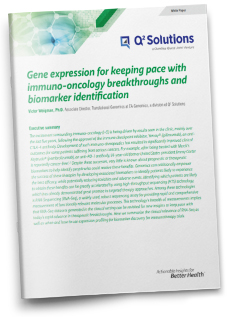
Gene expression for keeping pace with immuno-oncology breakthroughs and biomarker identification
When and how to use gene expression profiling
Author: Victor Weigman, Ph.D., Associate Director, Associate Director, Translational Genomics, Q2 Solutions
The excitement surrounding immuno-oncology (I-O) is being driven by results seen in the clinic, mainly over the last five years, following the approval of the immune checkpoint inhibitor, Yervoy® (ipilimumab), an anti-CTLA-4 antibody. Development of such immuno-therapeutics has resulted in significantly improved clinical outcomes for some patients suffering from serious cancers. For example, after being treated with Merck’s Keytruda® (pembrolizumab), an anti-PD-1 antibody, 91-year-old former United States president Jimmy Carter is reportedly cancer-free.1,2 Despite these successes, very little is known about prognostic or therapeutic biomarkers to help identify people who could receive these benefits. Genomics can additionally empower the success of these therapies by developing associated biomarkers to identify patients likely to experience the best efficacy, while potentially reducing toxicities and adverse events. Identifying which patients are likely to obtain these benefits can be greatly accelerated by using high- throughput sequencing (HTS) technology, which has already demonstrated great promise in targeted therapy approaches. Among these technologies is RNA-Sequencing (RNA-Seq), a widely used, robust sequencing assay for providing rapid and comprehensive measurement of functionally relevant molecular processes. This technology’s breadth of measurements implies that RNA-Seq datasets generated in the clinical setting can be revisited for new insights to keep pace with today’s rapid advance in therapeutic breakthroughs. Here we summarize the clinical relevance of RNA-Seq as well as when and how to use expression profiling for biomarker discovery for immunotherapy trials.
Complete the form below to access this white paper








